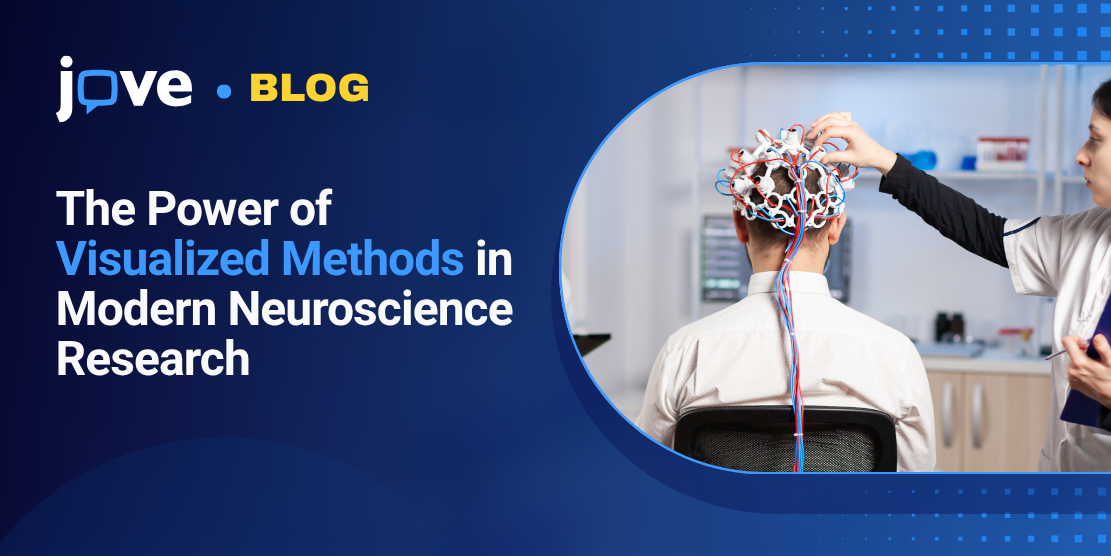During my postgraduate research on schizophrenia genetics, I became more and more fascinated by how the brain works. Its electrical signals, molecular pathways, and constant adaptability intrigued me, yet it often felt like a system that revealed just enough to keep its deeper logic out of reach.
Today, the brain remains one of science’s most complex mysteries: a network of billions of cells that somehow gives rise to thought, emotion, and behavior.
That mystery is also what drives so much of neuroscience research. From decoding neural circuits to visualizing how diseases alter the brain’s structure, progress often depends on finding new ways to see what was once hidden. The recent JoVE webinar Advancing Neuroscience Research with Video Articles explored this idea, showing how visualizing experiments can help research teams share methods and insights more effectively across labs and disciplines.
Each advance in technique chips away at the brain’s mystery, opening new ways to learn, teach, and explore its complexity.
Why Neuroscience Needs Visual Methods
Many neuroscience techniques are difficult to learn from text alone. The methods sections of papers often describe precise manipulations—like the angle of a microelectrode or the pressure applied during tissue perfusion—that are almost impossible to visualize from words.
This challenge is common across experimental fields. Studies have shown that video improves transparency and reproducibility in behavioral science,1 and the same holds true for neuroscience, where fine motor actions define data quality.
Neuroscience research typically combines several steps, like tissue preparation, electrophysiology, imaging, and analysis. Each requires exact timing and coordination. Videos capture the rhythm of real experiments, showing how success looks in practice and how creativity emerges through technique. As Dr. Elizabeth Jonas (Yale School of Medicine) shared in the webinar session, “To have the privilege and pleasure to make a movie about some of our techniques… that was really truly exciting.”
By making these methods visible, researchers create shared mental models that make collaboration smoother and lab training more effective.
Teaching the Craft of Neuroscience
Much of what defines a neuroscientist’s skill set is learned through mentorship and repetition. Video learning helps bridge the gap between written instruction and real lab practice by making expertise accessible to anyone, from undergraduates to postdocs joining new projects.
Dr. Jonas, who studies mitochondrial metabolism in neurons, noted that her lab relies on video articles to support hands-on training. Demonstrations, like those on preparing hippocampal slices for electrophysiological recording, have helped students and trainees master delicate techniques and gain confidence in experimental work.
Demonstration-based learning has long been shown to strengthen skill transfer and boost confidence in biomedical education.2 Being able to pause, rewind, and observe each step repeatedly allows students to internalize both technique and reasoning before attempting the procedure themselves.
Protocol Areas Where Video Adds Value
Across neuroscience, videos help standardize methods that rely on precision and timing:
- 🎬 Brain slice physiology: Demonstrates tissue handling and electrode positioning for high-quality recordings.
- 🎬 Imaging and analysis workflows: Shows how to align optical components, prepare indicators, and process data.
- 🎬 Behavioral neuroscience: Illustrates synchronization between movement tracking and neural data capture.
- 🎬 Neuromodulation and clinical translation: Visualizes electrode placement and stimulation setup safely.
- 🎬 Case-based approaches: Highlights subtle diagnostic or surgical steps that can be difficult to describe.
These visual references make training more efficient and ensure that research outputs are comparable across institutions.
Connecting People, Not Just Procedures
Video methods also help connect people. They create a shared practical language across labs, universities, and disciplines. A behavioral neuroscientist can watch a cellular recording to see how electrodes are positioned and signals stabilized, while a clinical researcher can learn from lab-based techniques that shape diagnostic or therapeutic studies.
By making methods visible and transparent, scientists open the door to collaboration and innovation. Visualized protocols capture more than a sequence of steps; they preserve the mentorship, curiosity, and human problem solving that drive research forward.
Looking Forward: Visual Methods for Discovery
Modern neuroscience increasingly depends on integrating data from multiple modalities: imaging, electrophysiology, and computational models. As these datasets grow, so does the need for clear, standardized procedures.
Video-based methods ensure that crucial procedural details remain visible and reproducible, even as technologies evolve. They help preserve not only the data but the craft behind how that data was produced.
With every improvement in how we study the brain, a little more of its mystery comes into focus. Reliable, visualized methods allow neuroscience to move faster, learn more broadly, and build stronger connections across research communities.
Explore how video-based resources can advance your research.
- Baker, D. H., & Gallistel, R. (2019). Transparency and reproducibility in behavioral science. Frontiers in Psychology, 10, 2685. https://www.ncbi.nlm.nih.gov/pmc/articles/PMC6373476/
- Sorensen, J. L., et al. (2021). Video-based learning in medical education: Systematic review. Advances in Physiology Education, 45(3), 511–518. https://doi.org/10.1152/advan.00123.2021







